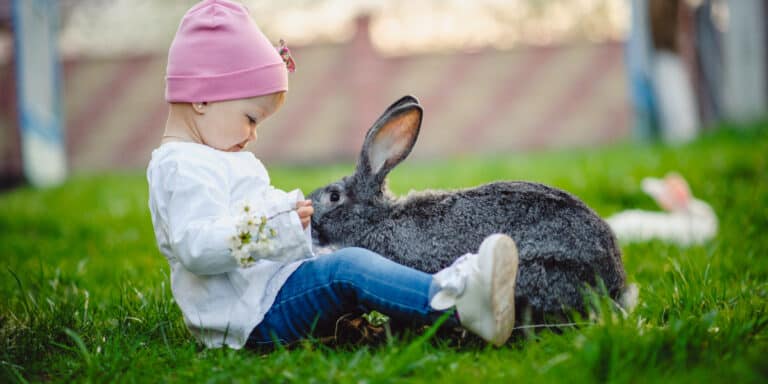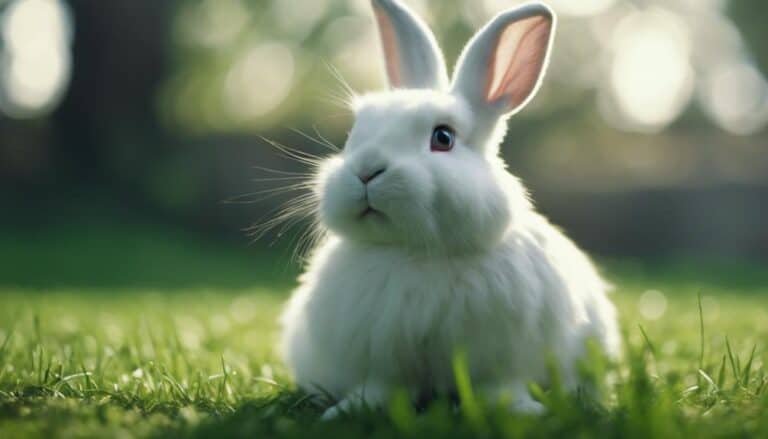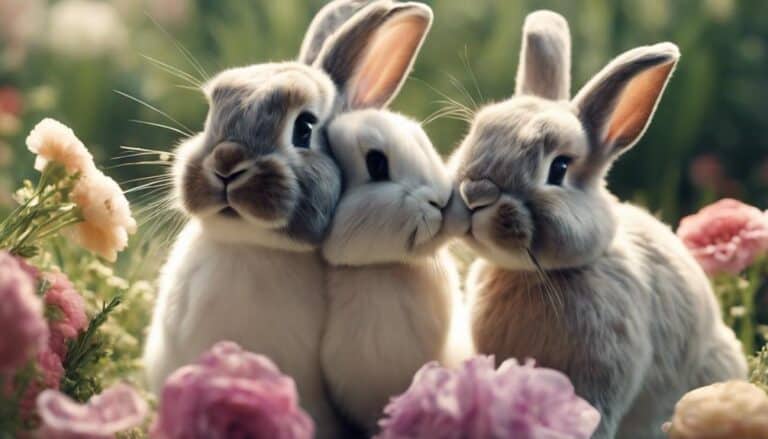As you peer into the intricate social world of bunnies, you will uncover a domain teeming with hidden complexities and subtle nuances. From their subtle forms of communication to the dynamic interplay of dominance and submission within bunny groups, these furry creatures navigate a world of intricate social dynamics that often go unnoticed.
Understanding the layers of bunny social structure promises a fascinating journey into a world where every twitch of a nose or flick of an ear holds a deeper meaning, waiting to be deciphered.
Contents
- 1 Key Takeaways
- 2 Bunny Social Structure
- 3 Communication Among Bunnies
- 4 Dominance and Submission in Bunny Groups
- 5 Establishing Bunny Hierarchy
- 6 Aggression and Conflict Resolution
- 7 Bonding and Social Interactions
- 8 Role of Gender in Bunny Groups
- 9 Factors Influencing Group Dynamics
- 10 Frequently Asked Questions
- 11 Can Bunnies Pick Up on Human Emotions in Their Social Interactions?
- 12 Conclusion
Key Takeaways
- Queen bunnies play a vital role in decision-making and maintaining order in colonies.
- Communication among bunnies involves vocalizations, scent marking, body language, and ear positioning.
- Dominance hierarchies are crucial for social interactions within bunny groups.
- Gender roles influence group dynamics, with female rabbits often leading and establishing dominance.
Bunny Social Structure
Within bunny colonies, the social structure is intricately organized around a dominant female known as the queen. This hierarchy plays a critical role in determining the distribution of resources such as food and shelter among colony members. The dominant female's leadership plays a vital role in determining the distribution of resources such as food and shelter among colony members. The dominant female's leadership guarantees the group's survival by making strategic decisions and maintaining order within the community.
As the dominant female, the queen bunny communicates her status through various behaviors. These include grooming, nipping, and chasing other members of the colony. Through these actions, she establishes her authority and ensures that her directives are followed by the rest of the group. This communication is essential for maintaining the stability of the social structure and facilitating cooperation among colony members.
In bunny colonies, the dominant female's role is pivotal in shaping the social dynamics and ensuring the well-being of the group. By understanding the significance of the queen bunny in the social structure, one can appreciate the intricate balance of power and communication that exists within these fascinating animal communities.
Communication Among Bunnies
The complex social structure of bunny colonies is intricately maintained through a variety of communication methods, including vocalizations, scent marking, body language, and ear positioning. Bunnies utilize a range of vocalizations such as grunts, honks, and teeth grinding to convey different messages within their groups. Scent marking is another critical form of communication among bunnies, helping them establish territories and share valuable information.
Body language plays a significant role in bunny communication. They express emotions and intentions through actions like thumping their hind legs or engaging in social grooming. Social grooming, in particular, is essential for strengthening bonds and promoting group cohesion among bunnies. This behavior not only helps in maintaining social harmony but also serves as a form of communication that reinforces relationships within the colony.
Moreover, bunnies communicate through ear positioning, using this subtle cue to convey feelings of relaxation, alertness, or aggression to others in their group. By incorporating these various communication methods, bunnies navigate their social world with precision and clarity, ensuring effective interactions and maintaining the harmony of their colonies.
Dominance and Submission in Bunny Groups
In bunny groups, dominance hierarchies play an crucial role in social interactions among individuals.
Dominant bunnies exhibit assertive behaviors to establish their status, while submissive bunnies display deferential actions to show respect.
Understanding the intricate dynamics of dominance and submission is essential for maintaining order and minimizing conflicts within bunny groups.
Hierarchy in Bunny Groups
How do dominant individuals establish authority within hierarchical bunny groups, and what behaviors signify submission among bunnies?
Dominance in bunny groups is established through a variety of behaviors, including grooming and mounting, while submissive bunnies display deferential actions such as grooming dominant individuals and avoiding direct eye contact. Here are some key points to consider when observing the hierarchy within bunny groups:
- Dominant individuals often engage in grooming and mounting behaviors towards subordinates.
- Submissive bunnies display deference by grooming dominant individuals and avoiding direct eye contact.
- Factors like age, gender, and social dynamics can influence the hierarchy within bunny groups.
- Understanding dominance and submission behaviors is essential for maintaining peace and order within the group.
- Aggressive behaviors, such as chasing and nipping, may be used to establish dominance or resolve conflicts.
Social Interactions Among Bunnies
Establishing social hierarchy among bunnies involves a complex interplay of physical interactions and subtle behavioral cues. In bunny groups, dominance is typically asserted through actions such as mounting, chasing, and nudging. Dominant bunnies exhibit behaviors like chin marking, head lowering, and circling to establish their status within the group.
On the other hand, submissive bunnies display signs of deference by grooming the dominant bunny, avoiding direct eye contact, and lying flat. Understanding these dynamics of dominance and submission is important for maintaining harmony and preventing conflicts within the social structure of bunny colonies.
Social hierarchies play an important role in resource allocation and ensuring orderliness within the group, contributing to the overall well-being of the bunny community.
Establishing Bunny Hierarchy
Within a bunny group, the establishment of hierarchy relies on dominant-subordinate relationships. In the intricate social world of rabbits, establishing bunny hierarchy is important for maintaining order and structure within the group.
Here are some key points to think about:
- Dominant bunnies assert their status through behaviors like chin rests, nudges, or mounting.
- Subordinate bunnies show submission by grooming the dominant bunny, avoiding direct eye contact, or lying flat on the ground.
- Hierarchy plays an important role in regulating access to essential resources such as food, shelter, and mates.
- Understanding bunny hierarchy provides valuable insights into group dynamics and social interactions among rabbits.
- The hierarchy among bunnies isn't fixed and can change based on various factors like age, size, health, and individual personalities.
Aggression and Conflict Resolution

Aggression in bunnies manifests through various behaviors such as biting, thumping, and boxing, serving as important indicators of conflict within their social dynamics. When conflicts arise among bunnies, they engage in a series of behaviors aimed at resolving these disputes. Conflict resolution mechanisms in bunnies include social grooming, nudging, and displaying submissive behaviors to appease the dominant rabbit. Aggression in bunnies can be triggered by various factors like territorial disputes, competition for resources such as food or shelter, or challenges to the established social hierarchy.
Bunnies communicate during conflicts using a combination of body language, vocalizations, and scent marking. These forms of communication help in expressing dominance, submission, or territorial claims. Establishing clear dominance hierarchies within a bunny group can notably reduce aggression and promote harmonious interactions. By defining social ranks and roles, bunnies can minimize conflicts and create a more stable social environment conducive to their well-being and group cohesion.
Bonding and Social Interactions
Social bonding among bunnies is a critical aspect of their social structure, facilitating group cohesion and emotional well-being. Bunnies form strong social bonds within their groups, displaying affection and grooming each other.
Social interactions among bunnies involve communication through body language, vocalizations, and scent marking. Group dynamics in bunny communities establish hierarchies based on dominance and resource access. Bunnies engage in communal activities like playing, exploring, and resting together to strengthen social bonds.
These interactions not only contribute to their overall well-being but also provide mental stimulation and emotional support within the group. Understanding the importance of social bonds, communication, and hierarchies in bunny communities sheds light on the intricate social world these animals inhabit.
Role of Gender in Bunny Groups
Gender dynamics in bunny groups greatly influence their social hierarchy and interactions. Female rabbits, also known as does, often take on leadership roles within the group, establishing dominance through various behaviors like grooming, nudging, or even gentle nips.
In contrast, male rabbits, referred to as bucks, may display dominant behaviors but typically defer to the female's leadership. This dynamic creates a structured social hierarchy where the does hold significant power in decision-making processes and resource allocation. Understanding these gender roles is essential as it impacts communication, breeding patterns, and access to essential resources within the group.
Factors Influencing Group Dynamics
Influences on the dynamics of bunny groups stem from a complex interplay of various factors within their colony structure. The hierarchy among bunnies, typically led by a dominant female, plays a crucial role in shaping group interactions. Social behaviors like grooming and sharing warmth are essential for maintaining cohesion within the group.
Communication through vocalizations, body language, and scent marking is important for establishing relationships and asserting dominance. Moreover, communal activities such as playful hopping, munching on greens, and cuddling contribute to the overall harmony of the group. Members actively engage in activities that foster camaraderie, affability, and familial love, ensuring the collective well-being of the burrow.
Understanding these factors – hierarchy, social interactions, and communication – provides insights into the intricate dynamics that govern bunny groups and highlights the importance of these aspects in maintaining a functional and harmonious social structure.
Frequently Asked Questions
What Are 3 Interesting Facts About Rabbits?
When exploring rabbit communication, you'll discover a sophisticated system of body language and vocalizations. Burrow architecture showcases intricate tunnel networks for shelter and safety. Predatory defenses include swift movements and keen senses to evade danger effectively in their natural habitat.
What Is a Rabbit's Social Behavior?
Wonder how rabbits establish dominance hierarchy? They use grooming behaviors and communication signals to maintain social order. Dominant rabbits exhibit control through grooming, mounting, and chasing subordinate members, emphasizing their status within the colony.
What Are the 5 Characteristics of Rabbit?
In rabbits, behavior reflects social structures, communication is diverse, and habitats vary. Rabbit behavior includes colony living, hierarchy establishment, and reproductive prolificacy. Communication involves vocalizations, body signals, and scent marking. Habitats range from warrens to burrows.
Why Did Rabbits Evolve to Be Cute?
Rabbits evolved to be cute as an evolutionary cuteness strategy. This survival advantage increased their chances of human care and protection. Genetic adaptability over time may have shaped their adorable appearance, fostering social bonding within warrens.
Can Bunnies Pick Up on Human Emotions in Their Social Interactions?
Bunnies are surprisingly perceptive when it comes to human emotions. They can pick up on subtle cues in social interactions and react accordingly. Studies have shown that bunnies are able to sense stress, happiness, and even sadness in their human companions, making them sensitive and empathetic pets.
Conclusion
To sum up, the intricate social world of bunnies is akin to a delicate dance of harmony and hierarchy. Like a well-orchestrated symphony, their communication, dominance dynamics, and conflict resolution strategies create a tapestry of interconnectedness and cooperation.
Just as each note in a melody contributes to the overall composition, every bunny plays a crucial role in maintaining the balance and unity within their colony.
The social world of bunnies is a fascinating glimpse into the beauty of collective living in the animal kingdom.






